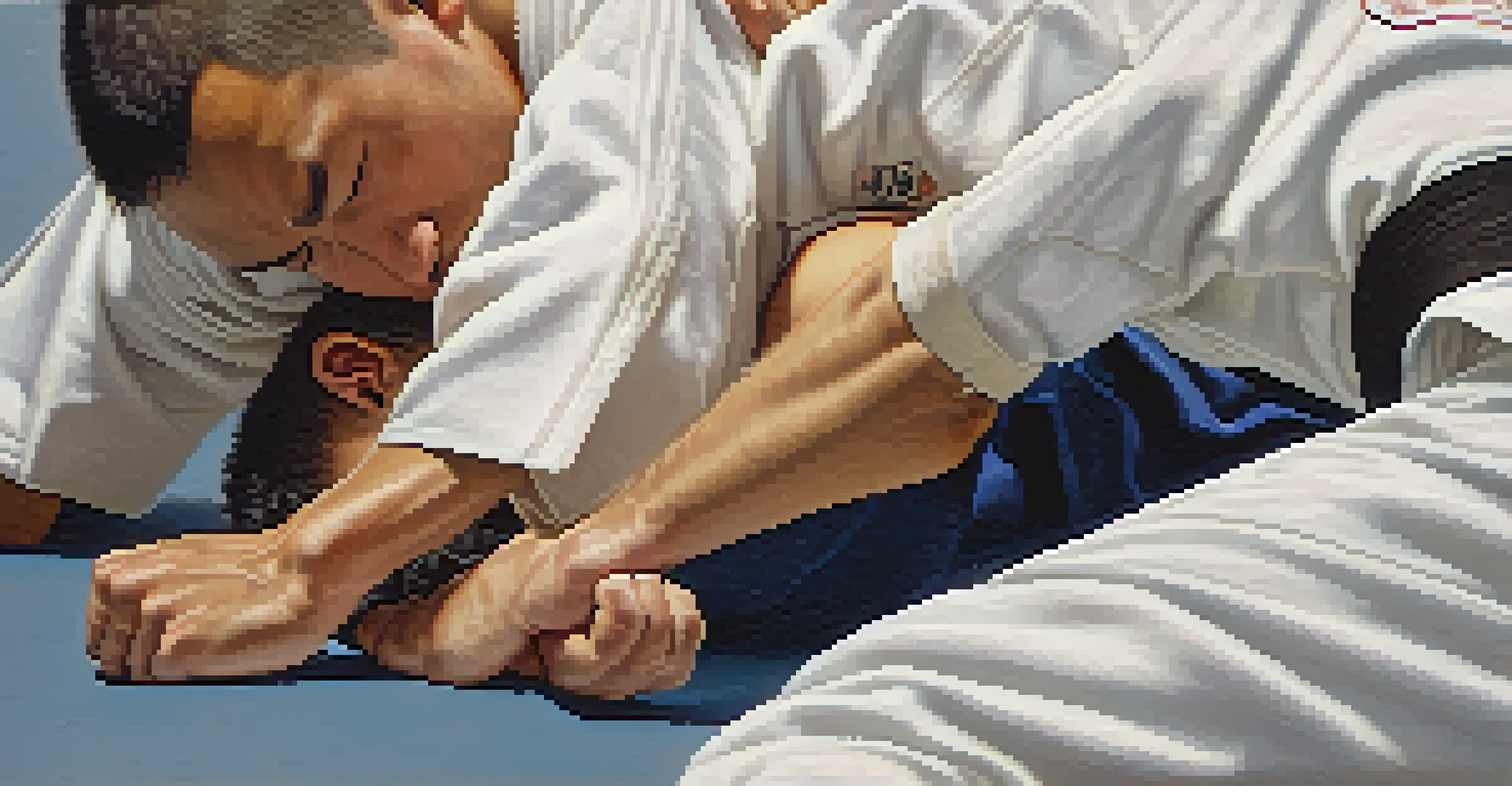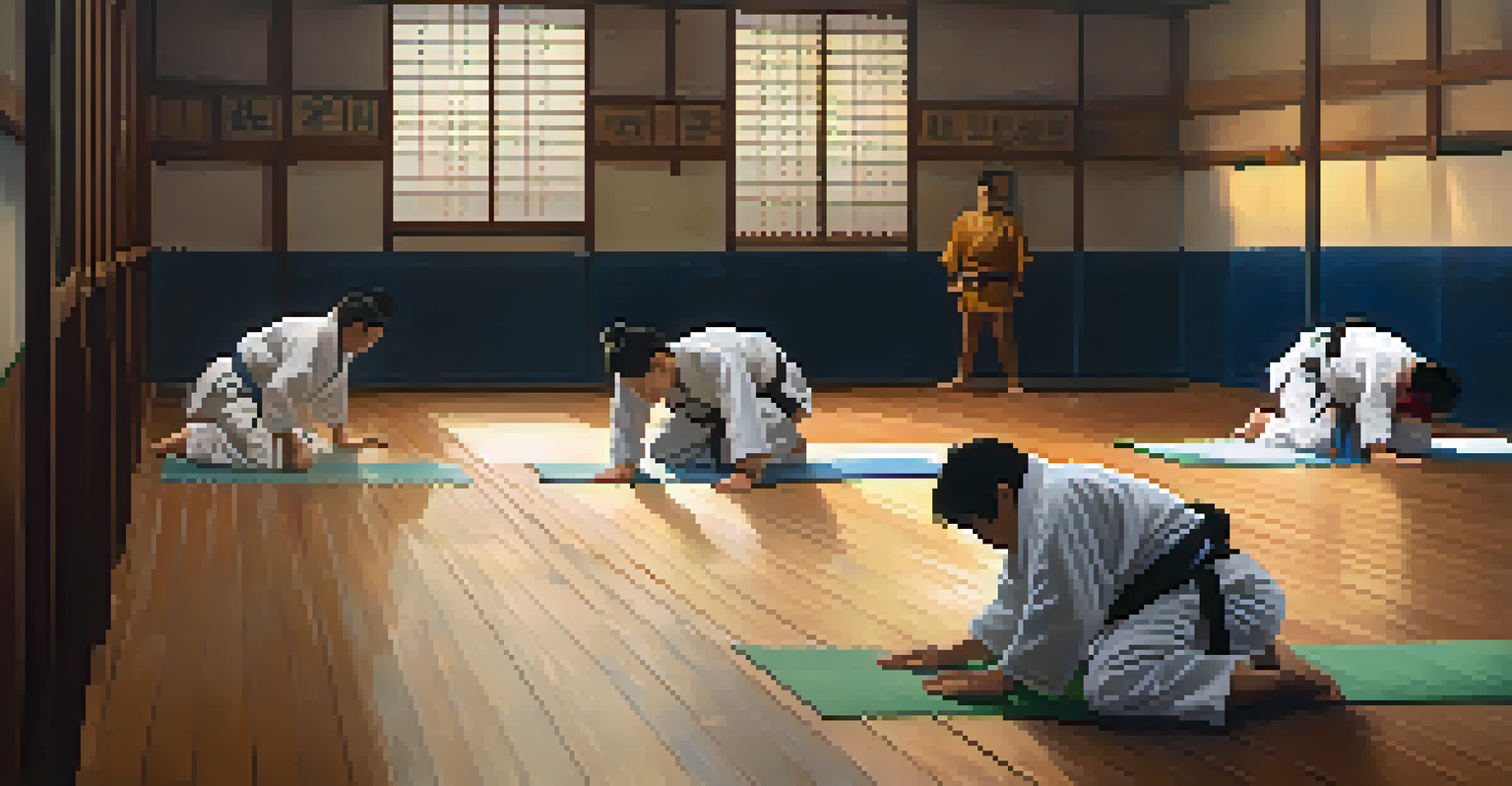Judo Techniques: Throws, Holds, and the Philosophy Behind Them

Understanding the Essence of Judo Techniques
Judo is more than just a martial art; it's a way of life. At its core, the techniques involve leveraging an opponent's force and balance against them, which is a principle known as 'maximum efficiency, minimum effort.' This philosophy not only applies to physical techniques but also to mental strategies, teaching practitioners to think critically and adapt swiftly.
The ultimate aim of judo is not to defeat the opponent but to perfect oneself.
The beauty of judo lies in its simplicity. Techniques like throws and holds are rooted in fundamental principles that can be learned by anyone, regardless of age or fitness level. Whether you're a beginner or an advanced judoka, understanding these basics is essential for mastering the sport.
Moreover, judo encourages respect and discipline, which are vital in both training and competition. Practitioners learn to value their opponents and themselves, creating a culture of mutual respect that enhances the overall experience of the martial art.
The Art of Judo Throws: Techniques and Types
Throws are the most dynamic and visually captivating aspects of judo. Techniques like the 'hip throw' (O Goshi) and 'shoulder throw' (Ippon Seoi Nage) showcase the elegance of utilizing balance and timing. Each throw requires precise body movement and an understanding of your opponent's center of gravity.

Different types of throws serve various purposes, whether it's to gain tactical advantage or to score points in competition. For example, a well-executed 'sacrifice throw' (Tachi Waza) can lead to an immediate victory if timed correctly. The thrill of executing a perfect throw is a feeling that many judokas cherish.
Judo Techniques Enhance Life Skills
Judo teaches practitioners valuable life lessons such as discipline, respect, and adaptability, making it more than just a martial art.
Practicing these throws helps build muscle memory and confidence. The more you practice, the more instinctive your reactions become, allowing you to adapt to any situation during a match. This adaptability is what makes judo not just a sport, but a lifelong journey of learning.
Exploring Judo Holds: Techniques and Importance
Holds, or 'ne-waza', play a crucial role in judo, offering a chance to control an opponent on the ground. Techniques like the 'knee-on-belly' (Knee-on-belly), and 'arm lock' (Juji Gatame) not only showcase technical skill but also mental fortitude. Mastering these holds can turn the tide of a match when executed properly.
In judo, there is no victory or defeat; it is all about learning and improving.
The importance of holds extends beyond competition; they teach practitioners patience and strategic thinking. In a world that often prioritizes speed, holds emphasize the value of maintaining control and waiting for the right moment to act.
Furthermore, practicing holds can enhance your overall grappling skills. They often require a different set of muscles and mental strategies compared to standing techniques, providing a well-rounded judo experience that keeps practitioners engaged and challenged.
The Philosophy of Judo: More Than Just Techniques
At its heart, judo is steeped in a rich philosophy that emphasizes personal growth and respect. The principles of 'Seiryoku Zenyo' (maximum efficiency) and 'Jita Kyoei' (mutual welfare and benefit) guide practitioners not only in techniques but also in their interactions with others. This philosophy fosters a sense of community among judokas.
Judo encourages individuals to push their limits while respecting their bodies and those of their opponents. This balance creates a safe environment for learning, allowing practitioners to explore their capabilities without fear of injury or failure.
Throws and Holds for Strategic Control
Mastering throws and holds in judo not only showcases technical skill but also emphasizes the importance of timing and control during matches.
Moreover, this philosophical foundation extends beyond the dojo. The lessons learned through judo—like discipline, perseverance, and respect—can be applied to everyday life, making it a transformative experience for many.
Judo and Self-Defense: Practical Applications
One of the most appealing aspects of judo is its practical application for self-defense. The techniques taught in judo can be effectively used in real-life situations, allowing individuals to defend themselves without relying on brute strength. Understanding how to throw or hold an opponent can provide a significant advantage.
Judo emphasizes using an opponent's force against them, which means that even a smaller individual can successfully defend against a larger attacker. This principle can empower practitioners, providing them with the confidence to handle confrontations.
Training in judo not only equips individuals with self-defense skills but also fosters a mindset of awareness and de-escalation. Practitioners learn to assess situations critically and respond appropriately, which is invaluable in today's world.
The Role of Sparring in Judo Development
Sparring, or 'randori', is an integral part of judo training that allows practitioners to apply techniques in a dynamic environment. Engaging in randori provides insights that drills alone cannot offer, helping judokas understand timing, distance, and the unpredictability of opponents. It's a space where theory meets practice.
Through sparring, judokas learn to adapt and refine their techniques on the fly. This real-time feedback is essential for growth; every session presents new challenges that build resilience and creativity. Over time, practitioners learn to anticipate their opponent's moves, enhancing their overall skill set.
Sparring Fosters Growth and Camaraderie
Engaging in sparring or randori allows judokas to apply techniques in real-time, encouraging resilience and building strong relationships with training partners.
Additionally, sparring fosters camaraderie among practitioners. Training together, sharing experiences, and pushing each other to improve creates strong bonds that often last a lifetime, enriching the judo journey.
Judo Training: Building Skills for Life
Training in judo is about more than just mastering techniques; it's about building character. The discipline required to practice regularly, learn new skills, and face challenges head-on instills valuable life lessons. These lessons, such as perseverance and respect for others, extend far beyond the dojo.
Moreover, judo training promotes physical fitness and mental well-being. The combination of strength, agility, and focus required in judo benefits both the body and mind, making it an excellent holistic workout. Practitioners often report increased confidence and reduced stress as a result.

Ultimately, judo shapes individuals into well-rounded persons. The skills and values learned through this martial art equip practitioners to navigate life's challenges with grace and determination, making judo a lifelong pursuit.